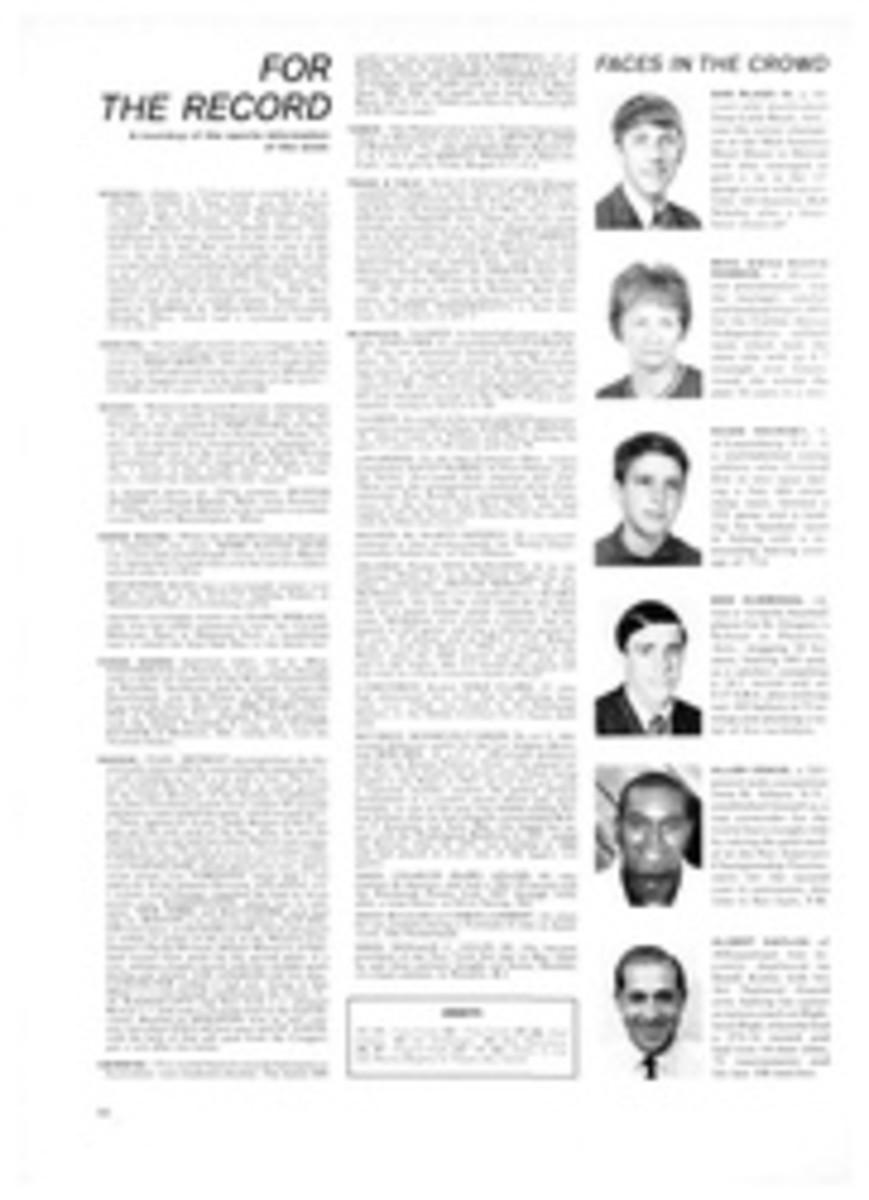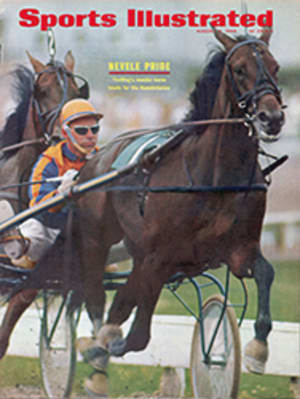
A PLACE IN THE BIG-CITY SUN
On any winter night anywhere in the U.S. the scene is familiar. High above the court in Providence, or in Peoria, or in Portland, a crowd will watch the kid with all the moves and marvel at him. He is so young, but so advanced. He has it all—the polish and the sense of the game and that special feel of the ball that can come only by growing up with it, bouncing it and shooting it against somebody else good almost every day of the year. The kid has got to be New York. The precocious ones with all the moves are almost sure to have learned the game on the hard and hot surface that is universally recognized as basketball's gut-and-soul home: the playground.
It is hardly a revelation that basketball, more than any other sport, is New York's game, the playground game. High-rise geography and the other realities of the urban core have dictated this. Where baseball and football cry out for grass and space, basketball asks only for concrete. Just a little bit of concrete. A kid in New York goes eight blocks to the concrete playground instead of 80 to the grass, and he shoots a basketball all year round. Even in the summer when the pavement burns and the only relief is the man with the snocones he goes to the playground and shoots a basketball.
The significant locus of all playground competition in New York has always been Harlem. They all play there, the aristocracy of the game and the anonymous, together. They play behind the fence on 138th Street off Fifth Avenue, or over by the St. Nicholas projects, or on a hundred other sidewalk courts around the area. So a guy picks up a game and finds himself guarding Jimmy Walker. Cool it, Jack, Harlem tells the guy. It is Harlem's justifiable boast and well-documented claim that the guy is probably as good as Walker, anyway. A man leaves his reputation and his clippings behind him when he comes to the Harlem playgrounds.
To be sure, it is somehow rare to find players who have to come to street-corner basketball; most are already there. One such man was Holcombe Rucker, a high school dropout and World War II veteran whose idea it was to transform pickup basketball into an organized activity for all the youngsters of Harlem. Today his efforts have come to maturity in a group of summer leagues that include a division for professional players. The Holcombe Rucker professional tournament now stands as the pinnacle of playground sport in America.
In reality, the "tournament" isn't a tournament at all; it is a league composed of nine teams that play each other once in a round-robin competition on weekends from June through August. Most of the teams in the tournament have a couple of players from the National Basketball Association; the remaining participants are lesser-known pros from the ABA, the Eastern League and the Globetrotters or the countless other touring teams from Harlem.
Risking imminent exhaustion from the 90° heat and what seems to be their own certain destruction on the steel posts that support the baskets, the players gather each Saturday and Sunday on the fenced-in courts of the 155th Street and Eighth Avenue playground. There, about two fast breaks away from the site of the old Polo Grounds, they are watched by upward of 3,000 spectators who arrive in all varieties of exotic summer costume and who, if the stark green wooden stands are filled, use beach chairs, orange crates and oil cans as their bleachers.
Over the heavy, staccato beat of the bongo drums on an adjacent playground, the public-address announcer, Walter Simpson, speaks through a bullhorn. Along with the running score and the time remaining, a skillful play-by-play of all the action is furnished with commentary spiced by such remarks as, "You know who got that one!" after a rebound by Jumping Johnny Green of the Philadelphia 76ers or, "Everybody take it easy; ain't nothin' happenin'!" after an uproar over an official's call. Mr. Simpson is very nearly as good as the Astrodome scoreboard itself; he does everything but blow up.
Though play is well-controlled and not so rough as a newcomer might expect, there is a considerable amount of freelancing and "get back" competition. Get back is instant playground reprisal. If a man exhibits his best move and scores on a negligent opponent, all hands yell, "Get back, get back," at the defender, whereupon he must immediately try to get back at the opponent who just took him. Promptly, with what is often a spectacular retaliatory move of his own, the second man usually does get back.
The audience is appreciative of all this and quite knowledgeable. The spectators are quick to detect the spurious move and overblown reputation, and they do not keep these discoveries to themselves. Often they are as much a spectacle as the scrimmages on the court. Included in their number sometimes are such heralded celebrities as Lew Alcindor, home for the summer to work in Mayor Lindsay's program, Operation Sports Rescue, and Wilt Chamberlain, who between contract negotiations has tooled up in his sparkling Dual-Ghia to catch the action of one team from which he has never been traded.
"There go 'The Dipper,' " says one little fan to his companion.
"Yeah," answers his buddy. "Let's go look at his car."
Chamberlain used to play in the Rucker tournament (his name still adorns the team's roster) and Alcindor will be eligible next year when he turns pro, but their regal presence is now only temporarily noted, their lure for the youngsters only momentary. The basketball itself is too good to be replaced by mere stargazing.
Indeed, much of the appeal of the Rucker pro tournament has come from witnessing a team of local favorites who never really made it stay even with a group of well-known pro players. News of the have-nots' successful exploits at the expense of the established NBA stars quickly gets around.
The New York Knickerbockers know about "The Ruckers," as the tournament is called by those who count. They know how tough it is. One of the Rucker teams practically is the New York Knickerbockers. On a recent afternoon this team—which includes Willis Reed, Emmette Bryant, Howard Komives, Nate Bowman, Neil Johnson and Fred Crawford, all of whom played at least part of last season with the Knicks—was beaten by the Urban League 83-71.
Some of the Urban League guys might be remembered. Bobby Hunter? Al Beard? Willie Hall? How about Frankie Townsend? Well, Hunter is a Globetrotter; Beard played last year with the New Jersey Americans (now the Long Island Americans or the Nassau County Nets or something); Hall is a former St. John's star, and Townsend is a 5'9" guard who was a hero when he played at C.W. Post College.
"You can play that way downtown, but it won't do you any good up here," one man shouted at the Knickerbocker players during their loss to the Urban League. Chauvinism extends only so far, however. On the second occasion of a Knick loss—this one to a crew known as Carmensville—the more knowing partisans admitted that the result would have been quite different if Reed had been present.
His basketball camp at Cornwall on the Hudson had kept Reed away this once, but consistent truancy by several key stars is the one flaw in an otherwise well-directed program. "Actually, we know when we start that several of the NBA men on the teams' rosters aren't going to show up for many of the games," says Bob McCullough, a 25-year-old junior high school teacher who is the coordinator of the tournament. "But some guys will tell a team's organizer to put them on the list so that when they do show up they can play. After all, there's 12 spots on each roster. Wilt came around last year practically begging to get into a game. He hadn't gotten on a roster, but they let him play anyway and then forfeited the game to the other team. Now, we've got Wilt, Dave Bing, Earl Monroe, Connie Hawkins, guys like that, all on the rosters. They may never show. But if they do we're ready." Bill Bradley appeared in town last week, but he had not signed up on the Knicks' roster in time, so could not play with his teammates. They finally did find an open place for him on Johnny Green's team.
Last summer Hawkins, the Most Valuable Player in the ABA, did not play in a single tournament game, yet he was voted to the all-star game by the coaches. Hawkins made an appearance in that contest and won the Most Valuable Player award. "If you're going to have an all-star game in Harlem," explains McCullough, "you vote for Connie or you don't vote."
McCullough, who was drafted out of Benedict College in South Carolina by the Cincinnati Royals in 1965, deserves much of the credit for the present status of the tournament. After Holcombe Rucker died of cancer in 1965 McCullough took over the direction of the league and financed uniforms, trophies and referees' salaries out of his own pocket. Then he met Harold Petersen, a community-minded salesman for the Schaefer brewery, and together they persuaded Schaefer Vice-President Andy Cooper to get the brewery to take over the sponsorship of the tournament last year.
"I think we're on solid ground now," says Freddie Crawford, the Laker guard and an assistant coordinator of the tournament. "And it's a good thing. I remember growing up with this league, coming out here every weekend with a crate to sit on and a few sodas and watching all the great pros play. I learned a lot just watching, and it kept me from getting messed up with other things. As a participant now, the tournament helps me get in shape, sure. But the best part is that it's fun. We play in the winter for money; we play now for relaxation."
To other men out to prove something, playground ball is more than pure relaxation. "You really can't compare a man's abilities in the yard with what he'd do when the pressure is on," says Tom Thacker, a reserve guard on the champion Boston Celtics. "But I know there are guys out here no one ever heard of who are better than some of the men sitting on the bench in our league. It's just a simple matter of getting the right breaks."
The Rucker crowds are particularly enthusiastic about the abilities of Globetrotters Hunter and 5'9" Pablo Robertson. Since Robertson temporarily left the Colonial team to answer an urgent call from the Trotters somewhere in Europe, Ronnie Jackson and Herman (Helicopter) Knowings were left with the major responsibility to entertain the playgrounds.
Why is Herman called Helicopter, one man wanted to know.
"Why is Herman called Helicopter?" replied McCullough. unbelieving and laughing. "Because Herman goes up in the air, Jack. Herman goes up like a heli-cop-ter!"
"Fly for me, 'Copter," is what all the fans yell at Herman Knowings. The 'Copter hardly ever hears any "get backs."
PHOTO
JOHN D. HANLON
Herman (Helicopter) Knowings, who plays with a local aggregation called the Colonial, blocks out Knickerbocker Center Nate Bowman.
PHOTO
JOHN D. HANLON
Spectators climb the fences to see the action.
PHOTO
JOHN D. HANLON
A few feet from the court a steady bongo beat competes with shrill cries of "get back."
PHOTO
JOHN D. HANLON
Being seven feet, like Lew Alcindor, can be as helpful for watching basketball as playing it.

